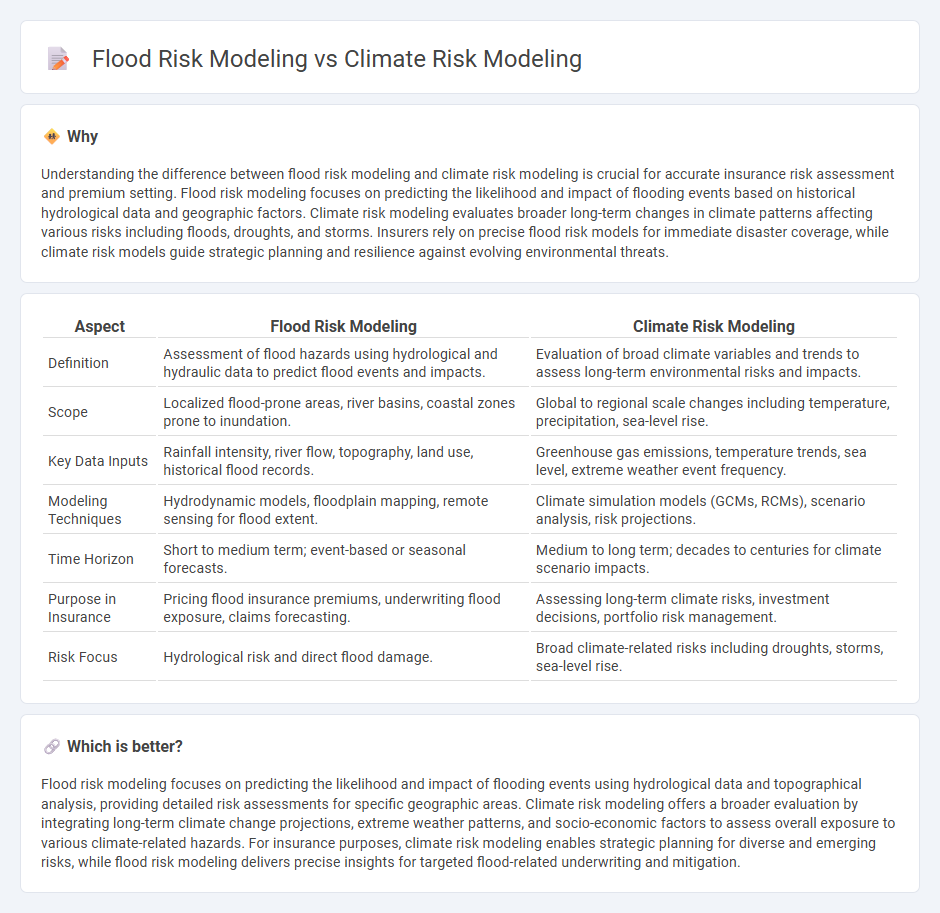
Flood risk modeling focuses on predicting the likelihood and impact of flooding events based on hydrological data, topography, and historical flood occurrences to assess local vulnerability. Climate risk modeling encompasses a broader scope, integrating long-term climate change projections, temperature fluctuations, and extreme weather patterns to evaluate potential future risks across multiple environmental factors. Discover how these modeling approaches enhance insurance strategies and resilience planning.
Why it is important
Understanding the difference between flood risk modeling and climate risk modeling is crucial for accurate insurance risk assessment and premium setting. Flood risk modeling focuses on predicting the likelihood and impact of flooding events based on historical hydrological data and geographic factors. Climate risk modeling evaluates broader long-term changes in climate patterns affecting various risks including floods, droughts, and storms. Insurers rely on precise flood risk models for immediate disaster coverage, while climate risk models guide strategic planning and resilience against evolving environmental threats.
Comparison Table
| Aspect | Flood Risk Modeling | Climate Risk Modeling |
|---|---|---|
| Definition | Assessment of flood hazards using hydrological and hydraulic data to predict flood events and impacts. | Evaluation of broad climate variables and trends to assess long-term environmental risks and impacts. |
| Scope | Localized flood-prone areas, river basins, coastal zones prone to inundation. | Global to regional scale changes including temperature, precipitation, sea-level rise. |
| Key Data Inputs | Rainfall intensity, river flow, topography, land use, historical flood records. | Greenhouse gas emissions, temperature trends, sea level, extreme weather event frequency. |
| Modeling Techniques | Hydrodynamic models, floodplain mapping, remote sensing for flood extent. | Climate simulation models (GCMs, RCMs), scenario analysis, risk projections. |
| Time Horizon | Short to medium term; event-based or seasonal forecasts. | Medium to long term; decades to centuries for climate scenario impacts. |
| Purpose in Insurance | Pricing flood insurance premiums, underwriting flood exposure, claims forecasting. | Assessing long-term climate risks, investment decisions, portfolio risk management. |
| Risk Focus | Hydrological risk and direct flood damage. | Broad climate-related risks including droughts, storms, sea-level rise. |
Which is better?
Flood risk modeling focuses on predicting the likelihood and impact of flooding events using hydrological data and topographical analysis, providing detailed risk assessments for specific geographic areas. Climate risk modeling offers a broader evaluation by integrating long-term climate change projections, extreme weather patterns, and socio-economic factors to assess overall exposure to various climate-related hazards. For insurance purposes, climate risk modeling enables strategic planning for diverse and emerging risks, while flood risk modeling delivers precise insights for targeted flood-related underwriting and mitigation.
Connection
Flood risk modeling relies heavily on climate risk modeling by integrating climate change projections such as increased rainfall intensity and sea-level rise to predict future flood scenarios accurately. Both models use hydrological data, weather patterns, and geographic information to assess vulnerability and financial exposure for insurance underwriting and risk management. The synergy between flood and climate risk modeling enhances insurers' ability to price policies effectively and develop strategies for mitigating flood-related losses amid changing climatic conditions.
Key Terms
**Climate risk modeling:**
Climate risk modeling evaluates the potential impacts of climate change on various sectors by analyzing temperature trends, precipitation patterns, and extreme weather event frequencies. It incorporates advanced algorithms and climate scenarios to forecast risks related to droughts, storms, and sea-level rise, providing comprehensive insights for long-term planning. Explore detailed methodologies and data sources used in climate risk modeling to enhance your understanding.
Emissions scenarios
Climate risk modeling incorporates emissions scenarios to predict long-term environmental changes driven by greenhouse gas concentrations, while flood risk modeling emphasizes localized hydrological impacts influenced by heavy rainfall and sea-level rise projections under these scenarios. Emissions scenarios like RCPs (Representative Concentration Pathways) guide both models, affecting predictions of temperature increases and extreme weather frequency. Explore detailed methodologies and applications of emissions-based risk assessments for comprehensive environmental planning.
Physical hazards
Climate risk modeling evaluates a broad spectrum of physical hazards including temperature shifts, extreme weather events, and sea-level rise, impacting ecosystems and infrastructure on a global to regional scale. Flood risk modeling specifically assesses hydrological and meteorological factors such as rainfall intensity, river discharge, and watershed characteristics to predict flood occurrences and impacts in localized areas. Explore comprehensive methodologies and applications to understand how these models inform disaster preparedness and mitigation strategies.
Source and External Links
How Companies Are Using Climate Modeling to Improve Risk Decisions - Climate risk models help organizations move beyond historical data to assess, quantify, and mitigate future climate impacts by integrating predictive climate science into risk frameworks, enabling better decision-making across industries.
Using model risk management to address climate analytics - Climate models are used for scenario analysis, risk scoring, and emissions estimation, helping banks and companies identify and manage both direct physical risks and indirect transition risks, while addressing uncertainties in second- and third-order climate impacts.
Climate risk modeling: What you need to know to get started - Climate risk modeling tools evaluate both acute and chronic physical risks from climate change, as well as transition risks, providing companies with forward-looking risk assessments to inform ESG strategy and resilience planning.
 dowidth.com
dowidth.com